Comparing Primary, Secondary, and Tertiary Care in Healthcare System
VerifiedAdded on 2023/06/12
|14
|2672
|128
Essay
AI Summary
This essay provides a comprehensive analysis of primary, secondary, and tertiary healthcare services, including a discussion of informal care. It begins by defining each level of care, providing specific examples such as a General physician (primary), St Thomas Hospital (secondary), Great Ormond Street Hospital for Children (tertiary), and Helping Hands (informal care). The essay then contrasts these services, highlighting differences in expertise, infrastructure, cost, and waiting times. The analysis emphasizes the distinct roles each level plays within the healthcare system, from initial consultation and specialist treatment to advanced care and long-term support for older and disabled individuals. The document is available on Desklib, where students can find a wealth of resources including solved assignments and past papers.

Running head: PRIMARY, SECONDARY AND TERTIARY CARE
Primary, secondary and tertiary care
Name of the student:
Name of the university:
Author note:
Primary, secondary and tertiary care
Name of the student:
Name of the university:
Author note:
Paraphrase This Document
Need a fresh take? Get an instant paraphrase of this document with our AI Paraphraser
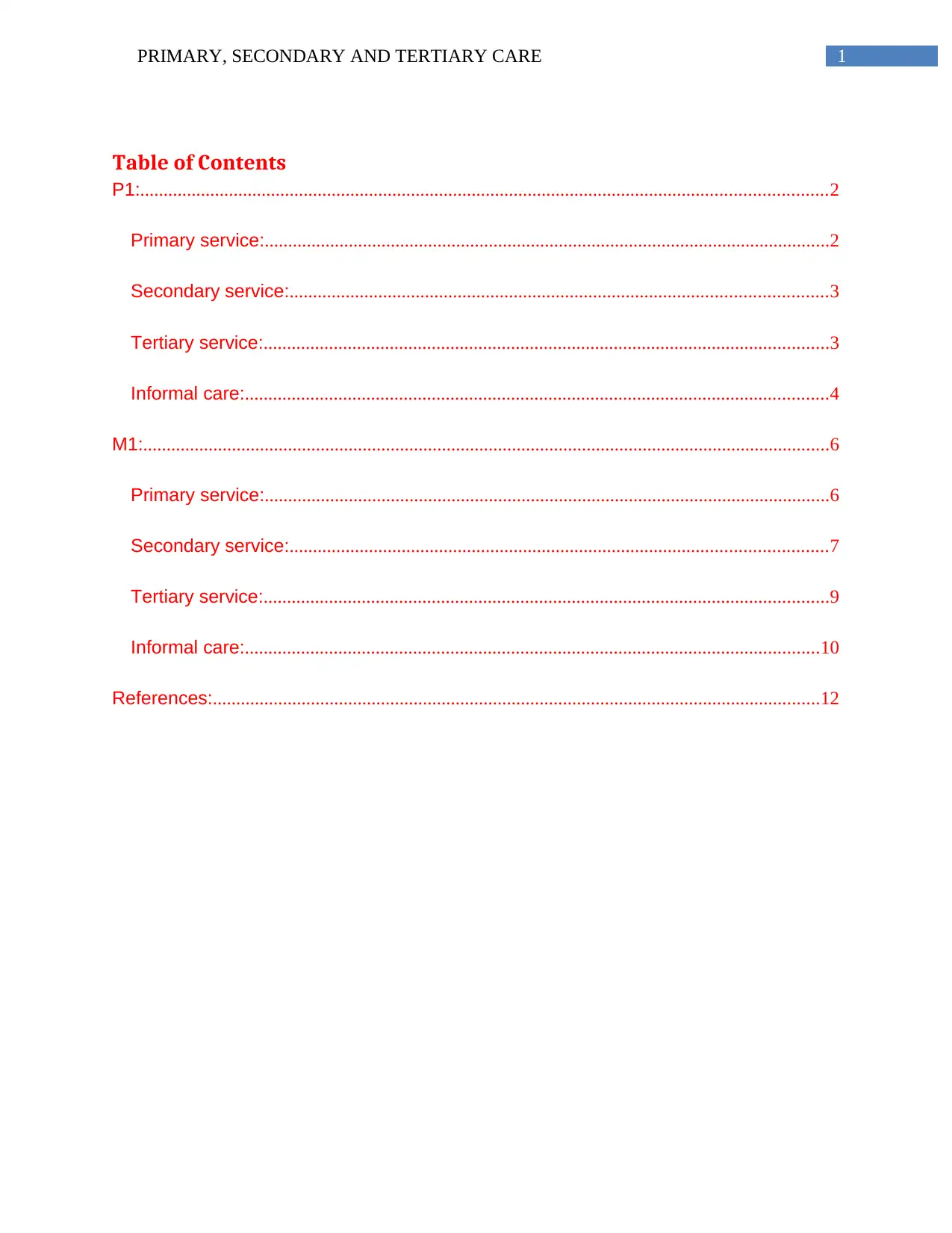
1PRIMARY, SECONDARY AND TERTIARY CARE
Table of Contents
P1:...................................................................................................................................................2
Primary service:.........................................................................................................................2
Secondary service:...................................................................................................................3
Tertiary service:.........................................................................................................................3
Informal care:.............................................................................................................................4
M1:...................................................................................................................................................6
Primary service:.........................................................................................................................6
Secondary service:...................................................................................................................7
Tertiary service:.........................................................................................................................9
Informal care:...........................................................................................................................10
References:..................................................................................................................................12
Table of Contents
P1:...................................................................................................................................................2
Primary service:.........................................................................................................................2
Secondary service:...................................................................................................................3
Tertiary service:.........................................................................................................................3
Informal care:.............................................................................................................................4
M1:...................................................................................................................................................6
Primary service:.........................................................................................................................6
Secondary service:...................................................................................................................7
Tertiary service:.........................................................................................................................9
Informal care:...........................................................................................................................10
References:..................................................................................................................................12
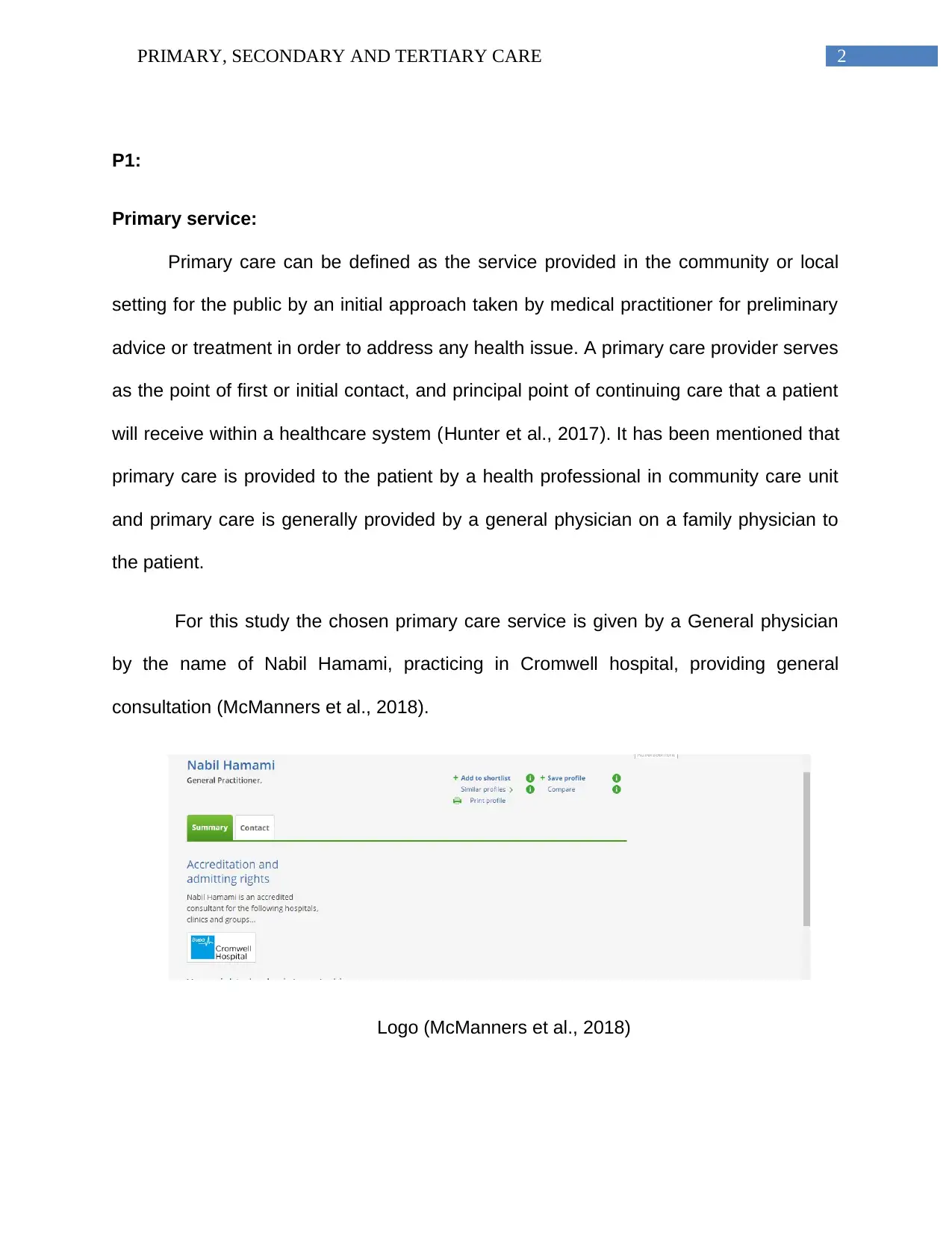
2PRIMARY, SECONDARY AND TERTIARY CARE
P1:
Primary service:
Primary care can be defined as the service provided in the community or local
setting for the public by an initial approach taken by medical practitioner for preliminary
advice or treatment in order to address any health issue. A primary care provider serves
as the point of first or initial contact, and principal point of continuing care that a patient
will receive within a healthcare system (Hunter et al., 2017). It has been mentioned that
primary care is provided to the patient by a health professional in community care unit
and primary care is generally provided by a general physician on a family physician to
the patient.
For this study the chosen primary care service is given by a General physician
by the name of Nabil Hamami, practicing in Cromwell hospital, providing general
consultation (McManners et al., 2018).
Logo (McManners et al., 2018)
P1:
Primary service:
Primary care can be defined as the service provided in the community or local
setting for the public by an initial approach taken by medical practitioner for preliminary
advice or treatment in order to address any health issue. A primary care provider serves
as the point of first or initial contact, and principal point of continuing care that a patient
will receive within a healthcare system (Hunter et al., 2017). It has been mentioned that
primary care is provided to the patient by a health professional in community care unit
and primary care is generally provided by a general physician on a family physician to
the patient.
For this study the chosen primary care service is given by a General physician
by the name of Nabil Hamami, practicing in Cromwell hospital, providing general
consultation (McManners et al., 2018).
Logo (McManners et al., 2018)
⊘ This is a preview!⊘
Do you want full access?
Subscribe today to unlock all pages.

Trusted by 1+ million students worldwide

3PRIMARY, SECONDARY AND TERTIARY CARE
Secondary service:
The second element of this study is the secondary care which is the next service
after primary care by being referred to the next step. The secondary care generally
comprises of a specialist (Haslam et al., 2016). At this point the patient will be looked
after by a healthcare professional who has more specific expertise in the health
adversity that the patient is feeling and can provide more experienced advice in both
diagnosis and treatment part of the procedure. Under the application of NHS, the
performance of secondary care is managed by the clinical commissioning groups. The
example chosen of secondary care in the study include hospitals providing the care of
Specialists.
The chosen hospital for the study is St Thomas Hospital which is funded by the
NHS Foundation trust. They provide Community Centre services of specialist secondary
care to the different individuals (Guysandstthomas.nhs.uk., 2018).
Logo (Guysandstthomas.nhs.uk., 2018)
Tertiary service:
A tertiary care hospital or tertiary referral hospital can be defined as a hospital
that provides tertiary care from the different specialists in large multispecialty healthcare
settings. In tertiary care settings the patients are referred from any primary care or
secondary care services. On a more elaborative note, tertiary care can be defined as a
Secondary service:
The second element of this study is the secondary care which is the next service
after primary care by being referred to the next step. The secondary care generally
comprises of a specialist (Haslam et al., 2016). At this point the patient will be looked
after by a healthcare professional who has more specific expertise in the health
adversity that the patient is feeling and can provide more experienced advice in both
diagnosis and treatment part of the procedure. Under the application of NHS, the
performance of secondary care is managed by the clinical commissioning groups. The
example chosen of secondary care in the study include hospitals providing the care of
Specialists.
The chosen hospital for the study is St Thomas Hospital which is funded by the
NHS Foundation trust. They provide Community Centre services of specialist secondary
care to the different individuals (Guysandstthomas.nhs.uk., 2018).
Logo (Guysandstthomas.nhs.uk., 2018)
Tertiary service:
A tertiary care hospital or tertiary referral hospital can be defined as a hospital
that provides tertiary care from the different specialists in large multispecialty healthcare
settings. In tertiary care settings the patients are referred from any primary care or
secondary care services. On a more elaborative note, tertiary care can be defined as a
Paraphrase This Document
Need a fresh take? Get an instant paraphrase of this document with our AI Paraphraser
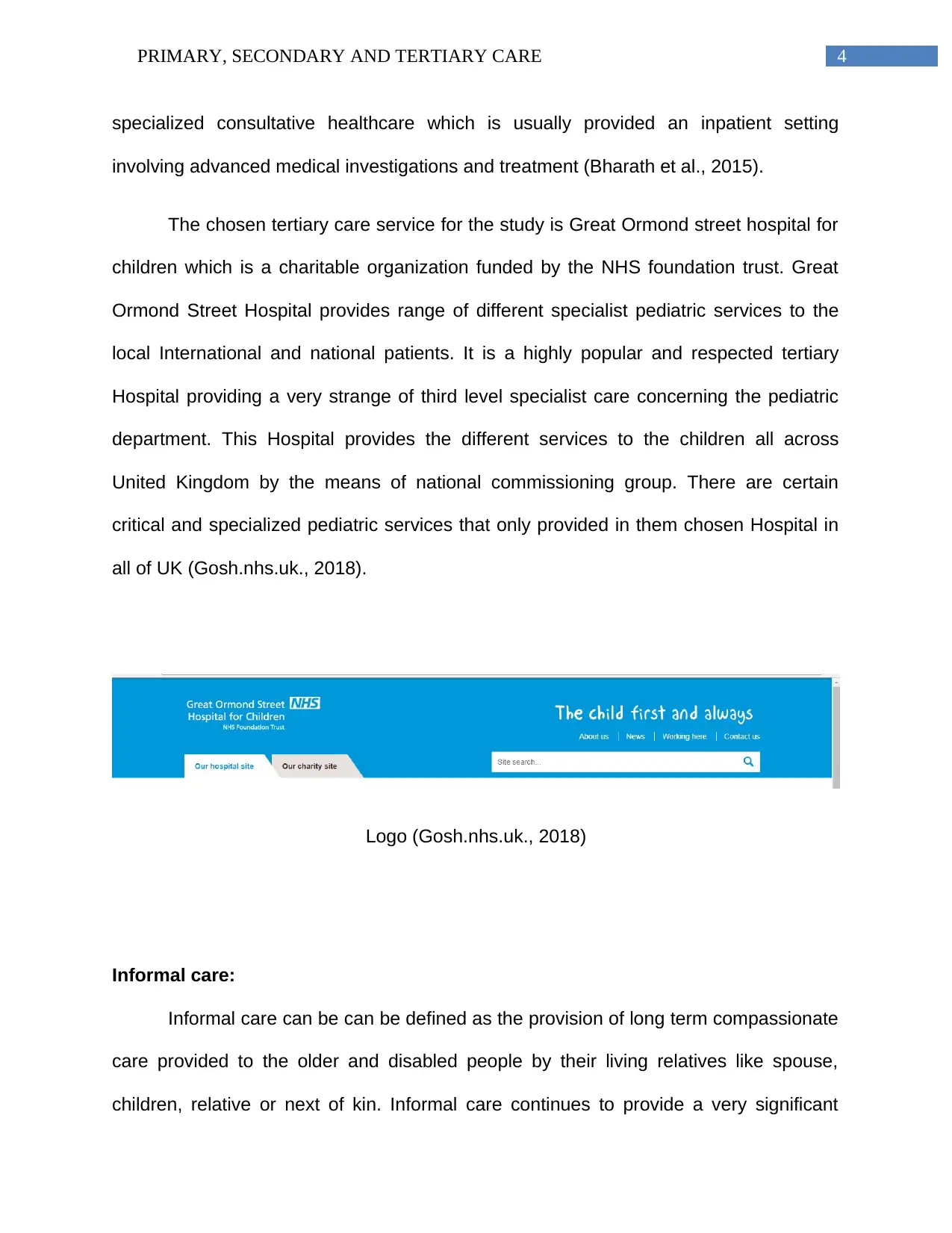
4PRIMARY, SECONDARY AND TERTIARY CARE
specialized consultative healthcare which is usually provided an inpatient setting
involving advanced medical investigations and treatment (Bharath et al., 2015).
The chosen tertiary care service for the study is Great Ormond street hospital for
children which is a charitable organization funded by the NHS foundation trust. Great
Ormond Street Hospital provides range of different specialist pediatric services to the
local International and national patients. It is a highly popular and respected tertiary
Hospital providing a very strange of third level specialist care concerning the pediatric
department. This Hospital provides the different services to the children all across
United Kingdom by the means of national commissioning group. There are certain
critical and specialized pediatric services that only provided in them chosen Hospital in
all of UK (Gosh.nhs.uk., 2018).
Logo (Gosh.nhs.uk., 2018)
Informal care:
Informal care can be can be defined as the provision of long term compassionate
care provided to the older and disabled people by their living relatives like spouse,
children, relative or next of kin. Informal care continues to provide a very significant
specialized consultative healthcare which is usually provided an inpatient setting
involving advanced medical investigations and treatment (Bharath et al., 2015).
The chosen tertiary care service for the study is Great Ormond street hospital for
children which is a charitable organization funded by the NHS foundation trust. Great
Ormond Street Hospital provides range of different specialist pediatric services to the
local International and national patients. It is a highly popular and respected tertiary
Hospital providing a very strange of third level specialist care concerning the pediatric
department. This Hospital provides the different services to the children all across
United Kingdom by the means of national commissioning group. There are certain
critical and specialized pediatric services that only provided in them chosen Hospital in
all of UK (Gosh.nhs.uk., 2018).
Logo (Gosh.nhs.uk., 2018)
Informal care:
Informal care can be can be defined as the provision of long term compassionate
care provided to the older and disabled people by their living relatives like spouse,
children, relative or next of kin. Informal care continues to provide a very significant
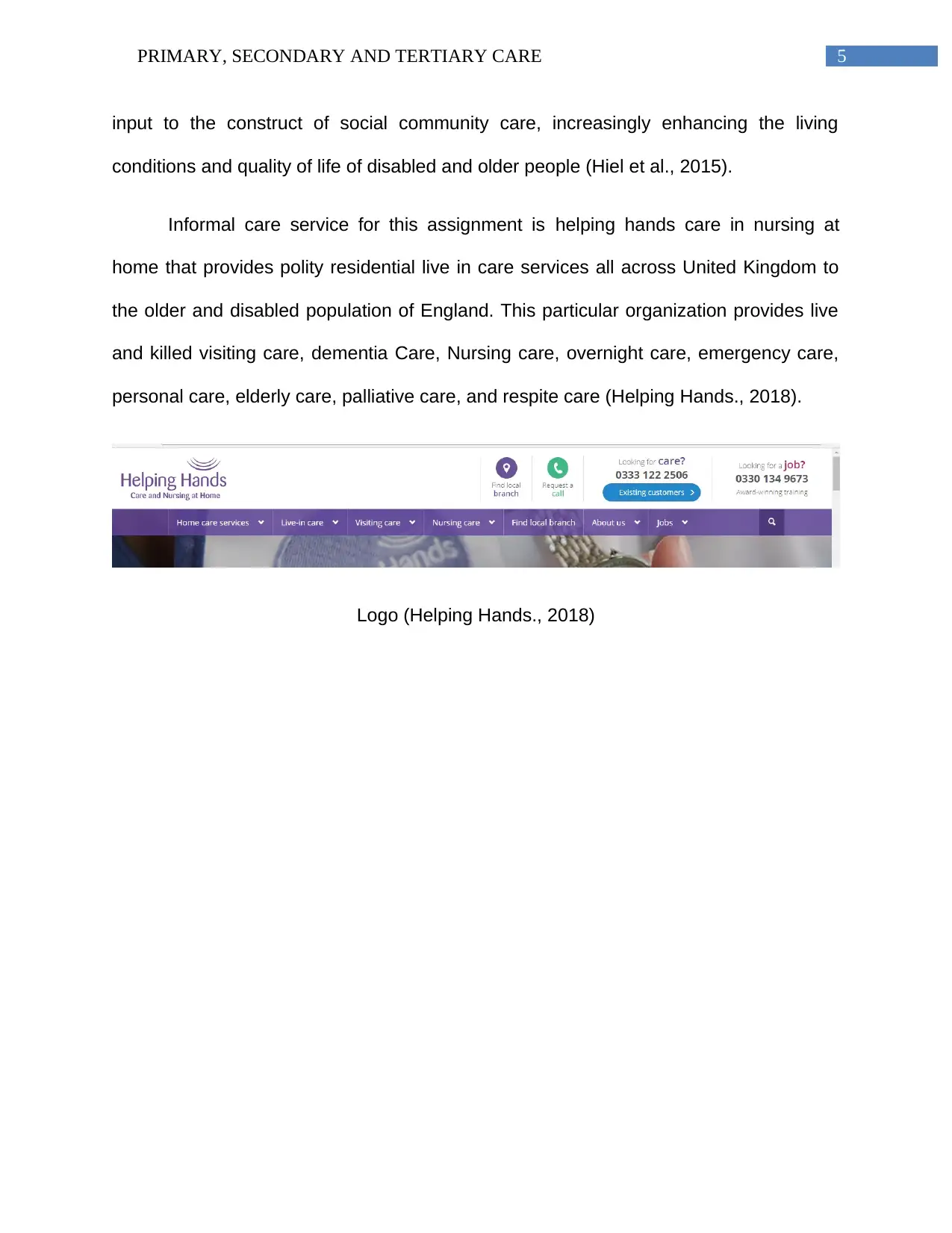
5PRIMARY, SECONDARY AND TERTIARY CARE
input to the construct of social community care, increasingly enhancing the living
conditions and quality of life of disabled and older people (Hiel et al., 2015).
Informal care service for this assignment is helping hands care in nursing at
home that provides polity residential live in care services all across United Kingdom to
the older and disabled population of England. This particular organization provides live
and killed visiting care, dementia Care, Nursing care, overnight care, emergency care,
personal care, elderly care, palliative care, and respite care (Helping Hands., 2018).
Logo (Helping Hands., 2018)
input to the construct of social community care, increasingly enhancing the living
conditions and quality of life of disabled and older people (Hiel et al., 2015).
Informal care service for this assignment is helping hands care in nursing at
home that provides polity residential live in care services all across United Kingdom to
the older and disabled population of England. This particular organization provides live
and killed visiting care, dementia Care, Nursing care, overnight care, emergency care,
personal care, elderly care, palliative care, and respite care (Helping Hands., 2018).
Logo (Helping Hands., 2018)
⊘ This is a preview!⊘
Do you want full access?
Subscribe today to unlock all pages.

Trusted by 1+ million students worldwide

6PRIMARY, SECONDARY AND TERTIARY CARE
M1:
Primary service:
Is different to:
Secondary care such (Saint Thomas Hospital) because available services from
primary care facilities such as a General physician in a local clinic will not have the
expertise to understand the underlying pathophysiology and etiology of a particular at
was health situation when compared to the available services provided by the
specialists from secondary care facility (Guysandstthomas.nhs.uk., 2018). The primary
service selected is privatized, and the entire cost will be on the patient where as the
secondary service selected is public funded with additional sources by trust donations.
However, the patient load is not as high in primary care services selected, hence the
waiting time is lesser in primary care.
Tertiary care service (Great Ormond Street hospital) for children because a
General physician cannot provide the advanced infrastructure and specialist expertise
knowledge that a pediatrician working in a highly advanced multispecialty specialist care
referral Hospital can provide through the available services by a tertiary hospital. The
primary service selected is privatized, and the entire cost will be on the patient where as
the tertiary service selected is also run by NHS foundation trust; hence the costs will be
minimal in comparison to primary care service selected. However, the patient load is
extremely high in tertiary care services selected, hence the waiting time is lesser in
primary care.
M1:
Primary service:
Is different to:
Secondary care such (Saint Thomas Hospital) because available services from
primary care facilities such as a General physician in a local clinic will not have the
expertise to understand the underlying pathophysiology and etiology of a particular at
was health situation when compared to the available services provided by the
specialists from secondary care facility (Guysandstthomas.nhs.uk., 2018). The primary
service selected is privatized, and the entire cost will be on the patient where as the
secondary service selected is public funded with additional sources by trust donations.
However, the patient load is not as high in primary care services selected, hence the
waiting time is lesser in primary care.
Tertiary care service (Great Ormond Street hospital) for children because a
General physician cannot provide the advanced infrastructure and specialist expertise
knowledge that a pediatrician working in a highly advanced multispecialty specialist care
referral Hospital can provide through the available services by a tertiary hospital. The
primary service selected is privatized, and the entire cost will be on the patient where as
the tertiary service selected is also run by NHS foundation trust; hence the costs will be
minimal in comparison to primary care service selected. However, the patient load is
extremely high in tertiary care services selected, hence the waiting time is lesser in
primary care.
Paraphrase This Document
Need a fresh take? Get an instant paraphrase of this document with our AI Paraphraser

7PRIMARY, SECONDARY AND TERTIARY CARE
Informal care service (Helping hands) because an informal care services such as
helping hands has available services such as compassionate residential care to the
older and disabled people only (provide assistance to activities of daily living and cannot
be performed by a general physician), which do not align with the available services
from Primary care services. The informal care services are completely privatized and
expensive, hence the costing is higher here than the primary service selected. However,
the patient load is not as high in tertiary care services selected, as it is a privatized
service, the waiting time is higher in case of GP than in informal care.
Secondary service:
Is different to:
Primary service (General physician) because it will provide comparatively higher
advanced and specialist care based on the expertise knowledge of the specialist and
the infrastructure provided by the hospital. The available services by a GP is just
general consultation where as a secondary hospital can provide services like oncology,
cardiovascular, pediatric, community care, dermatology, emergency care, maternal
services sexual health and urology. The primary service selected is privatized, and the
entire cost will be on the patient where as the secondary service selected is public
funded with additional sources by trust donations. Hence unlike the GP, here the costs
will be minimal for the patients. However, the patient load is not as high in primary care
services selected; hence the waiting time is higher in secondary care.
Informal care service (Helping hands) because an informal care services such as
helping hands has available services such as compassionate residential care to the
older and disabled people only (provide assistance to activities of daily living and cannot
be performed by a general physician), which do not align with the available services
from Primary care services. The informal care services are completely privatized and
expensive, hence the costing is higher here than the primary service selected. However,
the patient load is not as high in tertiary care services selected, as it is a privatized
service, the waiting time is higher in case of GP than in informal care.
Secondary service:
Is different to:
Primary service (General physician) because it will provide comparatively higher
advanced and specialist care based on the expertise knowledge of the specialist and
the infrastructure provided by the hospital. The available services by a GP is just
general consultation where as a secondary hospital can provide services like oncology,
cardiovascular, pediatric, community care, dermatology, emergency care, maternal
services sexual health and urology. The primary service selected is privatized, and the
entire cost will be on the patient where as the secondary service selected is public
funded with additional sources by trust donations. Hence unlike the GP, here the costs
will be minimal for the patients. However, the patient load is not as high in primary care
services selected; hence the waiting time is higher in secondary care.
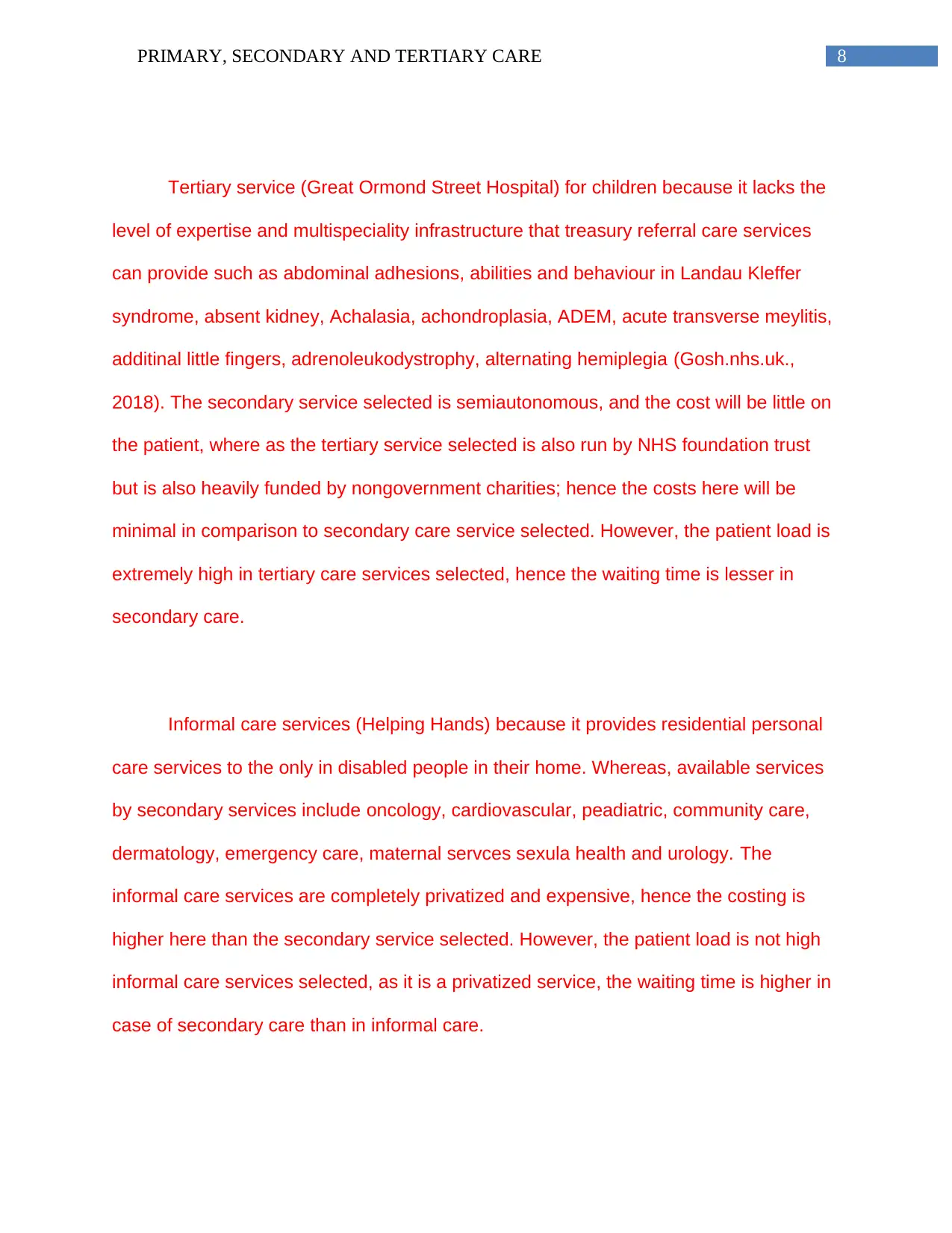
8PRIMARY, SECONDARY AND TERTIARY CARE
Tertiary service (Great Ormond Street Hospital) for children because it lacks the
level of expertise and multispeciality infrastructure that treasury referral care services
can provide such as abdominal adhesions, abilities and behaviour in Landau Kleffer
syndrome, absent kidney, Achalasia, achondroplasia, ADEM, acute transverse meylitis,
additinal little fingers, adrenoleukodystrophy, alternating hemiplegia (Gosh.nhs.uk.,
2018). The secondary service selected is semiautonomous, and the cost will be little on
the patient, where as the tertiary service selected is also run by NHS foundation trust
but is also heavily funded by nongovernment charities; hence the costs here will be
minimal in comparison to secondary care service selected. However, the patient load is
extremely high in tertiary care services selected, hence the waiting time is lesser in
secondary care.
Informal care services (Helping Hands) because it provides residential personal
care services to the only in disabled people in their home. Whereas, available services
by secondary services include oncology, cardiovascular, peadiatric, community care,
dermatology, emergency care, maternal servces sexula health and urology. The
informal care services are completely privatized and expensive, hence the costing is
higher here than the secondary service selected. However, the patient load is not high
informal care services selected, as it is a privatized service, the waiting time is higher in
case of secondary care than in informal care.
Tertiary service (Great Ormond Street Hospital) for children because it lacks the
level of expertise and multispeciality infrastructure that treasury referral care services
can provide such as abdominal adhesions, abilities and behaviour in Landau Kleffer
syndrome, absent kidney, Achalasia, achondroplasia, ADEM, acute transverse meylitis,
additinal little fingers, adrenoleukodystrophy, alternating hemiplegia (Gosh.nhs.uk.,
2018). The secondary service selected is semiautonomous, and the cost will be little on
the patient, where as the tertiary service selected is also run by NHS foundation trust
but is also heavily funded by nongovernment charities; hence the costs here will be
minimal in comparison to secondary care service selected. However, the patient load is
extremely high in tertiary care services selected, hence the waiting time is lesser in
secondary care.
Informal care services (Helping Hands) because it provides residential personal
care services to the only in disabled people in their home. Whereas, available services
by secondary services include oncology, cardiovascular, peadiatric, community care,
dermatology, emergency care, maternal servces sexula health and urology. The
informal care services are completely privatized and expensive, hence the costing is
higher here than the secondary service selected. However, the patient load is not high
informal care services selected, as it is a privatized service, the waiting time is higher in
case of secondary care than in informal care.
⊘ This is a preview!⊘
Do you want full access?
Subscribe today to unlock all pages.

Trusted by 1+ million students worldwide

9PRIMARY, SECONDARY AND TERTIARY CARE
Tertiary service:
This is different to:
Primary care services (general physician) because in tertiary care advisory
services are referred to by a General physician and it provides specialist and advanced
care services in the environment of Healthcare facility for acute or chronic conditions.
The primary service selected is privatized, and the entire cost will be on the patient
where as the tertiary service selected is public funded with additional sources by trust
donations. Hence unlike the GP, here the costs will be minimal for the patients.
However, the patient load is not as high in primary care services selected; hence the
waiting time is higher in tertiary care.
Secondary service (Saint Thomas hospital) because it can provide higher quality
advanced care and the secondary services from which the patients are referred to the
tertiary services. The tertiary service selected is public funded, and so is the secondary
service selected hence costs will be minimal in both cases. However, the patient load is
not as high in tertiary care services selected; hence the waiting time is lesser in tertiary
care in comparison with secondary care.
Informal services (Helping hands) because tertiary service is a specialized acute
or chronic condition care and it cannot provide home based residential services eating
the older and disabled in activities of daily living (Helping Hands., 2018). The informal
care services are completely privatized and expensive, hence the costing is higher here
than the tertiary service selected. However, the patient load is not high in informal care
Tertiary service:
This is different to:
Primary care services (general physician) because in tertiary care advisory
services are referred to by a General physician and it provides specialist and advanced
care services in the environment of Healthcare facility for acute or chronic conditions.
The primary service selected is privatized, and the entire cost will be on the patient
where as the tertiary service selected is public funded with additional sources by trust
donations. Hence unlike the GP, here the costs will be minimal for the patients.
However, the patient load is not as high in primary care services selected; hence the
waiting time is higher in tertiary care.
Secondary service (Saint Thomas hospital) because it can provide higher quality
advanced care and the secondary services from which the patients are referred to the
tertiary services. The tertiary service selected is public funded, and so is the secondary
service selected hence costs will be minimal in both cases. However, the patient load is
not as high in tertiary care services selected; hence the waiting time is lesser in tertiary
care in comparison with secondary care.
Informal services (Helping hands) because tertiary service is a specialized acute
or chronic condition care and it cannot provide home based residential services eating
the older and disabled in activities of daily living (Helping Hands., 2018). The informal
care services are completely privatized and expensive, hence the costing is higher here
than the tertiary service selected. However, the patient load is not high in informal care
Paraphrase This Document
Need a fresh take? Get an instant paraphrase of this document with our AI Paraphraser
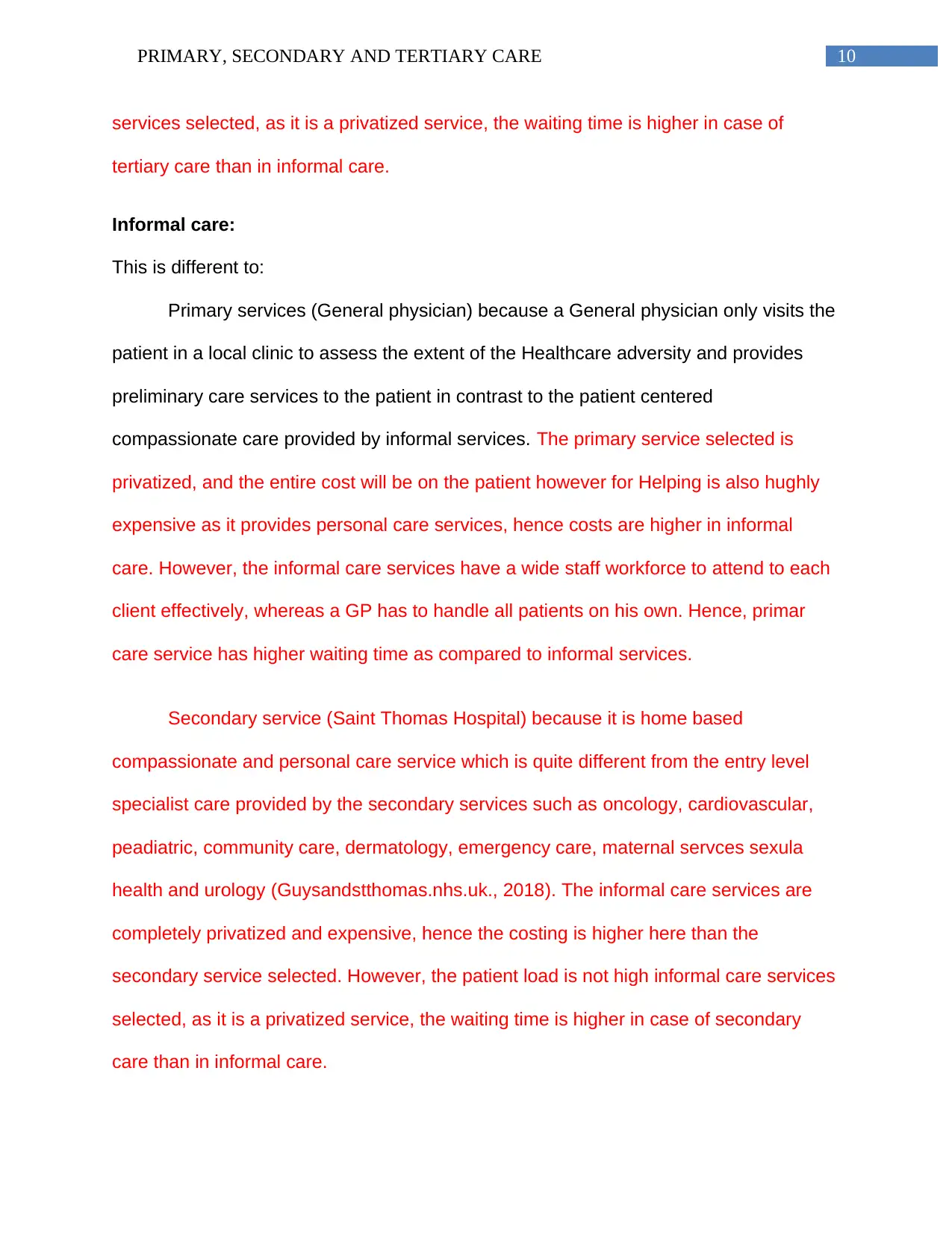
10PRIMARY, SECONDARY AND TERTIARY CARE
services selected, as it is a privatized service, the waiting time is higher in case of
tertiary care than in informal care.
Informal care:
This is different to:
Primary services (General physician) because a General physician only visits the
patient in a local clinic to assess the extent of the Healthcare adversity and provides
preliminary care services to the patient in contrast to the patient centered
compassionate care provided by informal services. The primary service selected is
privatized, and the entire cost will be on the patient however for Helping is also hughly
expensive as it provides personal care services, hence costs are higher in informal
care. However, the informal care services have a wide staff workforce to attend to each
client effectively, whereas a GP has to handle all patients on his own. Hence, primar
care service has higher waiting time as compared to informal services.
Secondary service (Saint Thomas Hospital) because it is home based
compassionate and personal care service which is quite different from the entry level
specialist care provided by the secondary services such as oncology, cardiovascular,
peadiatric, community care, dermatology, emergency care, maternal servces sexula
health and urology (Guysandstthomas.nhs.uk., 2018). The informal care services are
completely privatized and expensive, hence the costing is higher here than the
secondary service selected. However, the patient load is not high informal care services
selected, as it is a privatized service, the waiting time is higher in case of secondary
care than in informal care.
services selected, as it is a privatized service, the waiting time is higher in case of
tertiary care than in informal care.
Informal care:
This is different to:
Primary services (General physician) because a General physician only visits the
patient in a local clinic to assess the extent of the Healthcare adversity and provides
preliminary care services to the patient in contrast to the patient centered
compassionate care provided by informal services. The primary service selected is
privatized, and the entire cost will be on the patient however for Helping is also hughly
expensive as it provides personal care services, hence costs are higher in informal
care. However, the informal care services have a wide staff workforce to attend to each
client effectively, whereas a GP has to handle all patients on his own. Hence, primar
care service has higher waiting time as compared to informal services.
Secondary service (Saint Thomas Hospital) because it is home based
compassionate and personal care service which is quite different from the entry level
specialist care provided by the secondary services such as oncology, cardiovascular,
peadiatric, community care, dermatology, emergency care, maternal servces sexula
health and urology (Guysandstthomas.nhs.uk., 2018). The informal care services are
completely privatized and expensive, hence the costing is higher here than the
secondary service selected. However, the patient load is not high informal care services
selected, as it is a privatized service, the waiting time is higher in case of secondary
care than in informal care.
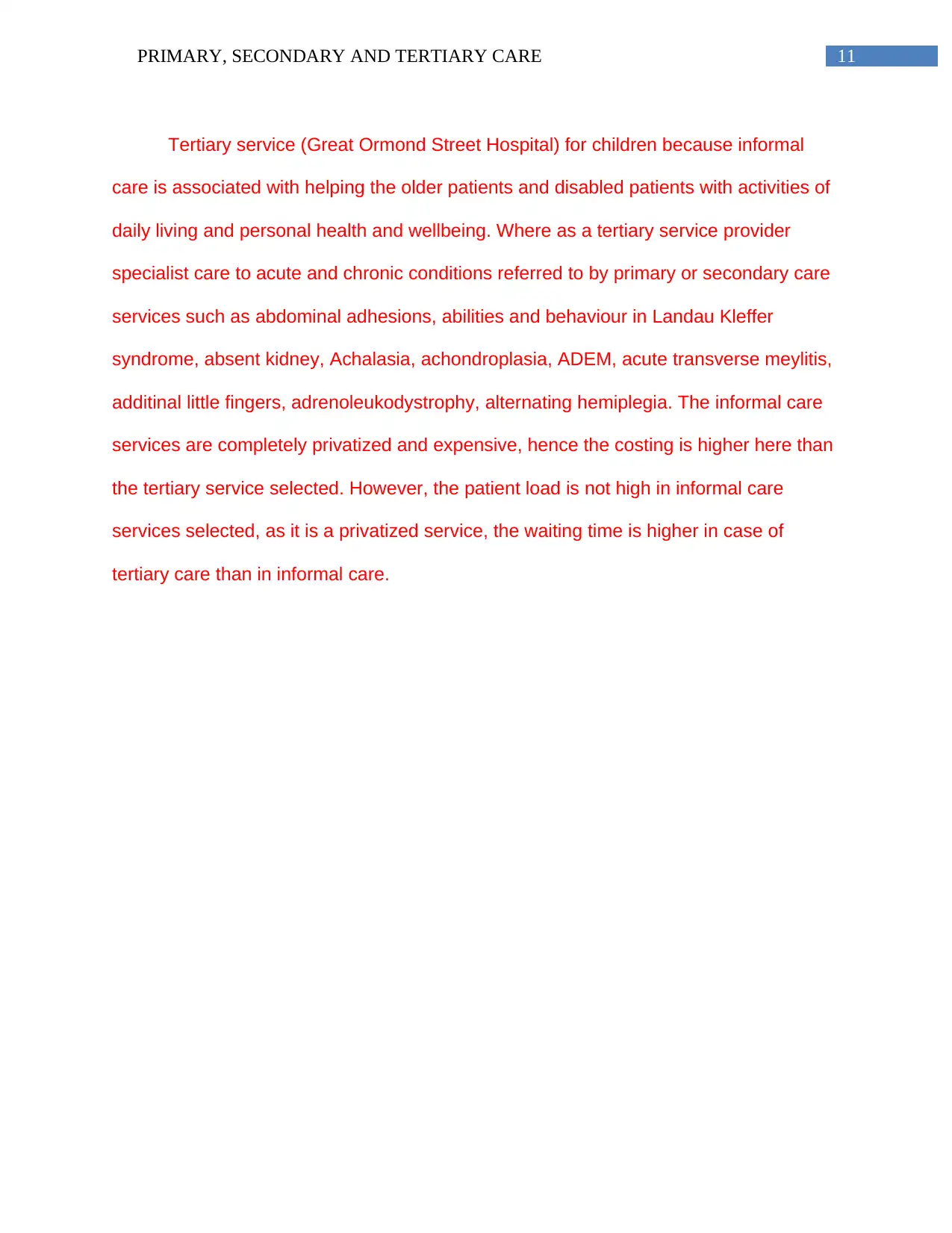
11PRIMARY, SECONDARY AND TERTIARY CARE
Tertiary service (Great Ormond Street Hospital) for children because informal
care is associated with helping the older patients and disabled patients with activities of
daily living and personal health and wellbeing. Where as a tertiary service provider
specialist care to acute and chronic conditions referred to by primary or secondary care
services such as abdominal adhesions, abilities and behaviour in Landau Kleffer
syndrome, absent kidney, Achalasia, achondroplasia, ADEM, acute transverse meylitis,
additinal little fingers, adrenoleukodystrophy, alternating hemiplegia. The informal care
services are completely privatized and expensive, hence the costing is higher here than
the tertiary service selected. However, the patient load is not high in informal care
services selected, as it is a privatized service, the waiting time is higher in case of
tertiary care than in informal care.
Tertiary service (Great Ormond Street Hospital) for children because informal
care is associated with helping the older patients and disabled patients with activities of
daily living and personal health and wellbeing. Where as a tertiary service provider
specialist care to acute and chronic conditions referred to by primary or secondary care
services such as abdominal adhesions, abilities and behaviour in Landau Kleffer
syndrome, absent kidney, Achalasia, achondroplasia, ADEM, acute transverse meylitis,
additinal little fingers, adrenoleukodystrophy, alternating hemiplegia. The informal care
services are completely privatized and expensive, hence the costing is higher here than
the tertiary service selected. However, the patient load is not high in informal care
services selected, as it is a privatized service, the waiting time is higher in case of
tertiary care than in informal care.
⊘ This is a preview!⊘
Do you want full access?
Subscribe today to unlock all pages.

Trusted by 1+ million students worldwide
1 out of 14
Related Documents
Your All-in-One AI-Powered Toolkit for Academic Success.
+13062052269
info@desklib.com
Available 24*7 on WhatsApp / Email
![[object Object]](/_next/static/media/star-bottom.7253800d.svg)
Unlock your academic potential
Copyright © 2020–2025 A2Z Services. All Rights Reserved. Developed and managed by ZUCOL.





